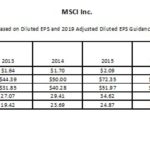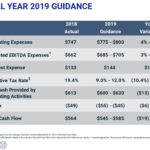Contents
Summary
- MSCI has recently released Q1 2019 results and updated guidance for FY2019.
- Following the ~65% increase in share price from the ~$137 December 2018 low I view shares to be richly valued.
- Rather than wait for MSCI to become more favorably valued before you initiate exposure, you can employ the use of the proposed reasonably conservative option trade.
- This proposed option trade provides you with the opportunity to maximize your profit if MSCI’s stock price retraces ~7.5% by September 20, 2019.
Introduction
I like to take positions in high quality companies with the view of being a long-term shareholder. Sometimes my analysis, however, leads me to the conclusion that the company I have analyzed is too richly valued for my liking or is a company in which I should not take a position.
In such cases I have employed the use of covered calls when I owned shares in the richly valued company.
When I had no exposure to the company I simply waited for the valuation to retrace to what I deemed to be an acceptable level.
In cases where I had no desire to take a position I simply passed and moved on.
One of my challenges has been that when the overvalued company I have analyzed eventually retraces to an acceptable valuation, it often occurs when other companies also are attractively valued. As a result, I often end up never initiating exposure to some companies which would appeal to me if they ever became reasonably valued.
After much internal deliberation I have recently decided to expand my use of options to overcome the above challenge. My plan is to now moderately expand the use of relatively conservative option strategies so I can potentially profit when my analysis suggests a company is overvalued or is a downright ‘dog’.
If the use of options is foreign to you and you are reluctant to use them, I can totally appreciate how you feel. There are over 30 option strategies which can be employed and many are far too complex for my liking and/or would require me to spend more time monitoring my investments than I want to.
I have found, however, that by employing a limited number of relatively low-risk option strategies I can take bullish and bearish positions and I can quantify my breakeven, maximum loss, and maximum profit from every trade.
This brings us to MSCI Inc (MSCI) which is currently trading at $226.93.
Some investors follow the axiom that ‘the trend is your friend’. Given the manner in which MSCI’s share price has behaved in recent months this would suggest that a pullback in MSCI’s share price is unlikely.
I do not follow this axiom and prefer to look at a company’s valuation based on earnings guidance versus historical valuation and to also look at the company’s future growth potential.
Over the long-term I agree that MSCI’s share price will most likely continue to rise. In the short-term, however, a pullback is not out of the realm of possibility. Looking at historical results and using guidance provided by management and a dozen analysts I am of the opinion that MSCI’s share price is apt to pullback within the next 4.5 months.
Business Overview
Please review Part 1 Item 1. Business (starts on page 17 of 158) and Part 1A Risk Factors (starts on page 31 of 158) in MSCI’s 2018 10-K to get a good overview of the company.
MSCI is a leader in providing global benchmarks to institutional investors. It has a recognizable brand and benefits from high switching costs making it difficult for rivals wishing to displace it.
On a daily basis it calculates over 215,500 benchmarks and 12,000 custom benchmarks for clients.
MSCI's indexes are a requirement for pension consultants and the index segment of the business accounts for ~75% of operating profits; the analytics division generates ~18% of operating income.
MSCI has benefited from the shift to low-cost passive investing and this trend will likely continue. The risk, however, is that ~23% of MSCI’s annual revenue is directly or indirectly linked to fund asset levels which would be severely negatively affected if we experienced a major market downturn.
There is also a risk wherein indexes become commodities. Should this happen, price will become a key differentiator versus brand and reputation as active asset managers come under increased pressure due to clients more closely scrutinizing fees and performance.
One of MSCI’s primary intangible assets is its MSCI-branded indexes. Many asset managers use these indexes to benchmark their investment performance because many foreign markets often do not have a widely recognized index as a benchmark for investment performance. Through its brand strength, MSCI has become the leader in benchmarking for these markets.
MSCI’s broad market-cap-weighted equity benchmarks (eg. MSCI EAFE Index) served as the foundation for the first index funds and were critical building blocks for the ETF industry.
MSCI’s two main businesses are indexes and analytics.
The index business accounts for ~76% of total adjusted EBITDA and the majority of MSCI’s profitability. This business has benefited from investor proliferation into new markets and increasingly complex strategies which has created opportunities for MSCI to create new country, industry and/or strategy specific benchmarks.
Some asset managers do not believe standard benchmarks adequately capture the risk and return profile of their investment strategies. MSCI has been able to create custom benchmarks to better measure the performance of individual portfolios or mandates.
Earnings are generated primarily by selling subscriptions to branded indexes and related data to customers for use as benchmarks. Customers will also license indexes and data when creating ETFs bearing the MSCI name as well as other investment vehicles. MSCI's fee is determined as a percentage of total assets under management for the index-linked product.
The analytics business contributes 22% of total adjusted EBITDA. Once again, MSCI benefits from high switching costs derived from its RiskMetrics Risk Manager and Barra product family.
RiskMetrics is a tool kit used to conduct risk simulation and stress test portfolios. Clients build risk and portfolio monitoring processes around this analytics offering, which can take years to design and can possibly take as much time to replace.
The Barra product family, the most widely used multifactor risk model currently in use, is a multifactor risk model tool that allows investors to make return forecasts and volatility projections based on different Barra risk factors (eg. momentum, value, size, and volatility).
Q1 2019 Results
MSCI’s Q1 Earnings Release can be found here and its accompanying presentation can be found here.
On the Q1 conference call with analysts, management indicated the business landscape looks solid and the subscription business remains on track.
Assets Under Management (AUM) and Equity ETFs linked to MSCI’s indexes are at all-time highs. This has been driven by healthy cash inflows and favorable market movements.
There was $28B of inflows during Q1 of which ~$9B came from funds based on U.S. exposure indexes. Much of these flows into U.S. exposure products were in the ETFs based on MSCI’s Factor Indexes (strong flows into low volatility and quality products). MSCI saw close to $12B of flows into ETFs based on its Factor and ESG Indexes.
FY2019 Guidance
The following guidance was provided when Q4 and FY2018 results were released.
Source: MSCI Q4 and FY2018 Earnings Presentation
Guidance presented in the Q1 2019 Earnings Presentation has been amended slightly.
Management has indicated that given the:
- strong business landscape;
- strong momentum witnessed in key growth areas;
- elevated levels of AUM and Equity ETFs linked to MSCI indexes relative to the beginning of the year,
MSCI plans to capitalize on some of the attractive growth opportunities by making modest incremental investments. On this basis, adjusted EBITDA expenses have been revised to the top end of the guidance range of $0.685B - $0.705B.
Credit Ratings
Moody’s downgraded MSCI’s unsecured long-term debt to Ba2 from Ba1 in August 2015. This is the middle tier of the non-investment grade (speculative) category.
S&P Global Ratings has rated MSCI BB+ since April 2012. This is the top tier of the non-investment grade (speculative) category.
These ratings are lower than what I like to see from companies in which I take a position. I am, however, proposing a very modest risk of capital exposure through the use of options versus the outright acquisition of shares.
Valuation
I provide the following spreadsheet in which I compare MSCI’s adjusted PE based on high/low/median earnings estimates and the high/low stock price in 2019 versus 2011 - 2018 high/low PE based on diluted EPS and the high/low stock price.
 MSCI Valuation - 2011 - 2018 PE Based on Diluted EPS and 2019 Adjusted Diluted EPS Guidance
MSCI Valuation - 2011 - 2018 PE Based on Diluted EPS and 2019 Adjusted Diluted EPS Guidance
I view MSCI as being richly valued when I compare MSCI’s historical valuation against current valuation.
In the option trade proposed later in this article, you maximize profitability if MSCI’s share price drops below $210. In my spreadsheet I have, therefore, reduced MSCI’s share price to $209.99 (a ~7.5% pullback from the current $226.93 share price) to determine what would be MSCI’s forward adjusted PE if we retained earnings guidance.
Based on the results, I think MSCI would still be richly valued if the share price were to experience a ~7.5% pullback.
Dividend and Dividend Yield
In the Q1 Earnings Release, MSCI indicated its Board declared a cash dividend of $0.58/share for Q2 2019. The Q2 2019 dividend is payable May 31, 2019 to shareholders of record as of the close of trading May 17, 2019. This will mark the 4th consecutive quarterly $0.58 dividend payment.
At $2.32/year, the current dividend yield is ~1% on the basis of the current $226.93 May 3, 2019 closing share price.
MSCI’s dividend history in recent years has been impressive. Investors, however, are highly unlikely to invest in MSCI for dividend income purposes. I do not, therefore, view any further discussion on this front as being of any value.
The diluted weighted average shares outstanding used in computing EPS has declined from 116,706 million in FY2014 to 89,701 million in FY2018. In Q1 2019, the weighted average diluted shares outstanding declined 7.5% to 85.6 million, compared to 92.6 million in Q1 2018. In Q1 2019, a total of 0.7 million shares were repurchased at an average price of $147.97/share for a total value of $102.1 million. A total of $0.7B remains on the outstanding share repurchase authorization as of April 30, 2019. Total shares outstanding as of March 31, 2019 was 84.7 million.
Option Strategies
I do not currently own any MSCI shares but this should not preclude me from taking a position in the company through the use of options.
Based on my analysis I am of the opinion MSCI is currently richly valued and a pullback in the share price is highly probable over the next few months. I am, therefore, prepared to take a bearish position using options.
Bear Call Spread Option Strategy
This strategy results in you collecting an upfront premium. A comparable strategy would be to use the Bear Put Spread but then you would have to lay out money at the time of the trades.
These are the trades I intend to place May 6th (rates reflected below are currently the ‘last price’ from the last trading day - May 3rd):
- Sell a $210 September 20, 2019 Call and generate $22.35/share
- Buy a $220 September 20, 2019 Call and pay $15.40/share
- Receive a net credit of $6.95/share (excludes nominal commission)
My breakeven is $216.95/share calculated as the $210/share strike price + $6.95/share premium I collected.
If shares close below $210 at expiry, the holder of the right to buy MSCI shares at $210 would let their options expire since they can acquire shares on the open market at a better price. In addition, I will let my right to buy MSCI shares at $220 expire. My maximum profit potential is, therefore, the $6.95/share I collected at the time of the trade.
If shares are trading at $215 as we approach expiry I would suffer a ~$5.00/share ($215 - $210) loss as I would close out the $210 Call. I collected $6.95/share at the time of the trade so I would be ahead $1.95/share (less commission).
On the maximum risk front, I stand to lose the most if MSCI is trading above $220 at expiry. If shares are trading at $230, for example, the holder of the Call would have the right to acquire shares from me at $210 meaning I am down $20/share. I, however, have the right to acquire shares at $220 so I am ahead $10/share on these options. The loss of $10/share would be partially offset by the $6.95/share I collected at the time I placed the option trades thus resulting in a maximum loss of $3.05/share.
Risks
There is always an element of risk when you invest, including when you employ the use of options.
Please read this explanation of Bear Call Spreads in which the risks associated with this option strategy are explained.
Final Thoughts
I think MSCI holds a promising long-term future and would like to initiate a position. I am, however, of the opinion MSCI is currently richly valued and will revisit MSCI at a later date to determine whether I should initiate a position. Until such time as I view MSCI as being reasonable valued, however, I am prepared to employ the use of options to try and extract some income while shares appear to be overvalued.
In my opinion, at least a 7.5% pullback between now and September 20, 2019 in MSCI’s share price from the current $226.93 is not an unrealistic expectation. My intent, therefore, is to initiate the Bear Call Spread proposed in this article once markets reopen on May 6th.
I wish you much success on your journey to financial freedom.
Thanks for reading!
Note: I sincerely appreciate the time you took to read this article. Please send any feedback, corrections, or questions to [email protected].
Disclaimer: I have no knowledge of your individual circumstances and am not providing individualized advice or recommendations. I encourage you not to make any investment decision without conducting your own research and due diligence. You should also consult your financial advisor about your specific situation.
Disclosure: I do not currently hold a position in MSCI but intend to initiate a bearish option position within the next 72 hours.
I wrote this article myself and it expresses my own opinions. I am not receiving compensation for it and have no business relationship with any company whose stock is mentioned in this article.




